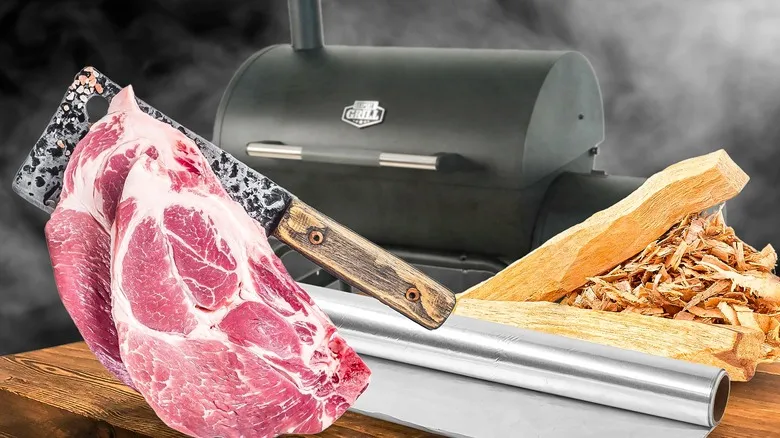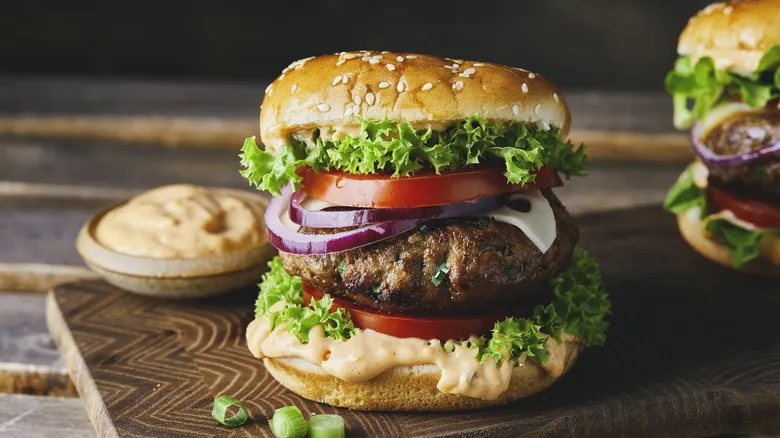Choose bone-in cuts of pork

Before you start smoking your pork, it's important to choose the right type of shoulder for your recipe. While you might be tempted to opt for boneless cuts, which are easier to slice and serve, smoking requires a cut that can withstand longer cooking times without drying out. Instead, seek out a bone-in pork shoulder, which you will leave intact during the smoking process. The bone contains marrow that adds moisture to the meat, along with small pockets of air that help regulate temperature for more consistent cooking.
"The McLemore Boys noted, 'Boneless pork shoulders are perfect for slow cookers, stews, and pulled pork. However, bone-in pork shoulders are best for low and slow smoking, resulting in delicious southern pulled pork.'"
So, when you head to the store to pick up your ingredients, make sure to choose a bone-in shoulder for optimal results. Just remember that the bone adds to the overall weight of the pork, so you may need to select a larger shoulder to achieve the desired amount of meat.
Let the pork marinate in brine
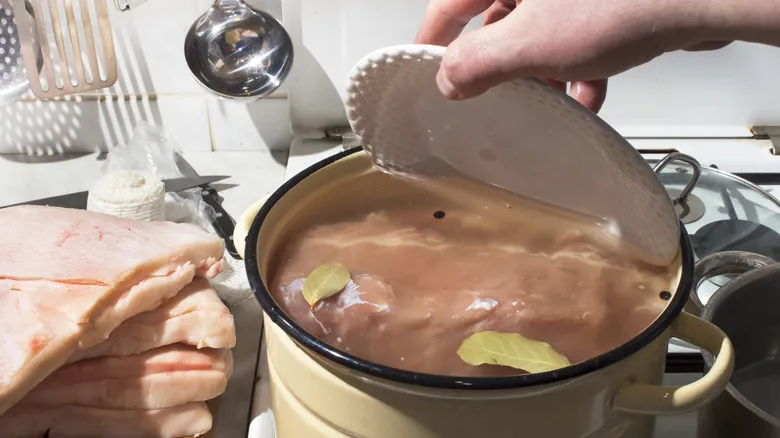
Marinating pork in a salty brine before smoking it will yield an exceptionally tender result. You can enhance the flavor further by incorporating spices and other ingredients. Rosangela Teodoro recommends using rosemary, thyme, and garlic in a brine made with salt and pepper for pork. For a simpler option, pickle juice serves as a convenient brine that includes flavors like dill and garlic.
A good brine requires ample salt to draw moisture into the meat, and adding sugar can provide a pleasant, subtle sweetness. Mix both salt and sugar in water, then let the solution cool completely before immersing your meat. Brining in warm water can start the cooking process, which may disrupt the optimal smoking time and conditions, so it's advisable to keep the brine cool.
Since pork shoulder can be quite large, choose a bowl or bag that can accommodate not only the meat but also enough water to fully submerge it. For the best results, refrigerate the entire brining container for one to two days.
Keep the fat on top

You might be inclined to choose the leanest pork shoulder available, believing it will yield more meat. However, fat is crucial for flavor and helps keep the meat moist. Pork shoulder typically has a thicker layer of fat on top and less marbling than pork butt. Therefore, avoid trimming all the fat off before placing your pork shoulder in the smoker. Instead, position the fat side up to allow the meat to absorb the drippings.
"The fat safeguards the cooking process and bastes the pork, ensuring the meat remains juicy," said Rosangela Teodoro. As the fat melts during smoking, it seeps into the meat, which is essential for preventing dryness. Given that smoking is a lengthy process, having the right amount of fat significantly reduces the risk of the meat becoming dry. While you can baste the meat with barbecue sauce, juice, or oil, the simplest way to ensure it stays flavorful, tender, and moist is to start with a cut that has ample fat.
Season the pork well
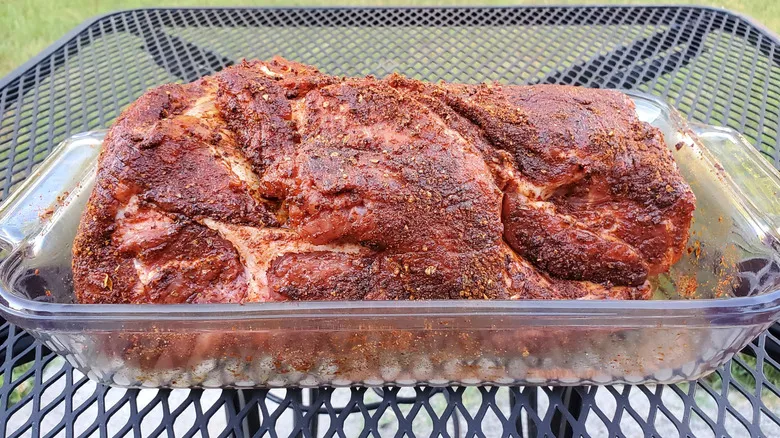
While pork boasts a naturally savory flavor, enhancing it with spices, seasonings, and rubs after brining can elevate its taste even further. Brining not only infuses the meat with flavor and ensures tenderness, but applying spices to the surface of the shoulder can also yield a crispier crust and a more pronounced taste. Be liberal with salt and pepper, along with other spices, before placing your pork in the smoker. This is the perfect moment to season the meat, allowing it to absorb these flavors during cooking.
"The majority of people prepare their shoulders by giving them a light rinse, patting them dry, and then applying a binder to help the rub adhere," say The McLemore Boys. "Binders typically include a mustard-based sauce or cooking oil, followed by any BBQ or pork rub that suits your taste preferences."
You can also introduce heat with spices like cayenne pepper or add savory notes with herbs like oregano. Even simple enhancements can add excitement to the dish. For instance, Rosangela Teodoro incorporates lemon into her seasoning mix when preparing pork. If fresh lemon isn't available, consider using lemon salt, such as citron sea salt flakes, as an alternative.
When it comes to temperature, go low
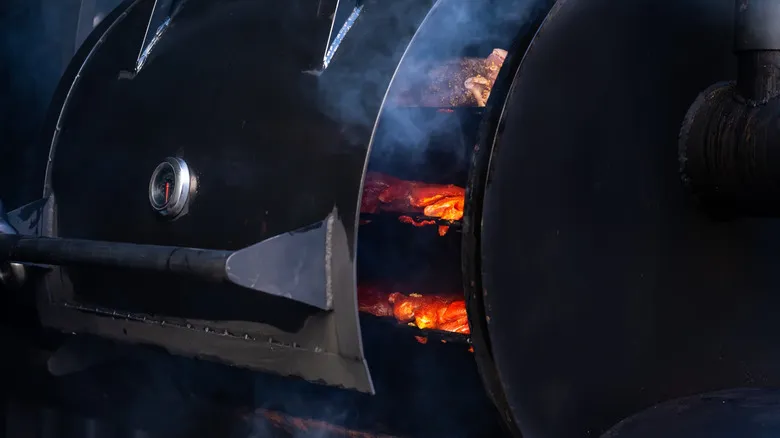
When smoking meats, it's important to maintain a low temperature to prevent drying out. Most smokers come with temperature controls that facilitate low and slow cooking. Keeping your pork shoulder at a low heat for an extended period ensures it remains incredibly tender.
"The typical range for smoking pork shoulders is between 200 and 275 degrees Fahrenheit," say The McLemore Boys. "If you're pressed for time, you can opt for a higher temperature around 350 degrees Fahrenheit, but be cautious to avoid overcooking or charring the bottom of the shoulder."
Temperature control is crucial in the smoking process, so be vigilant about your settings and the actual temperature inside. Utilize a thermometer to monitor the internal heat. A probe-style thermometer allows you to check the meat's temperature without lifting the smoker lid. If your smoker has a built-in thermometer, it's wise to periodically verify its accuracy with a separate unit.
Use wood chips for flavored smoke
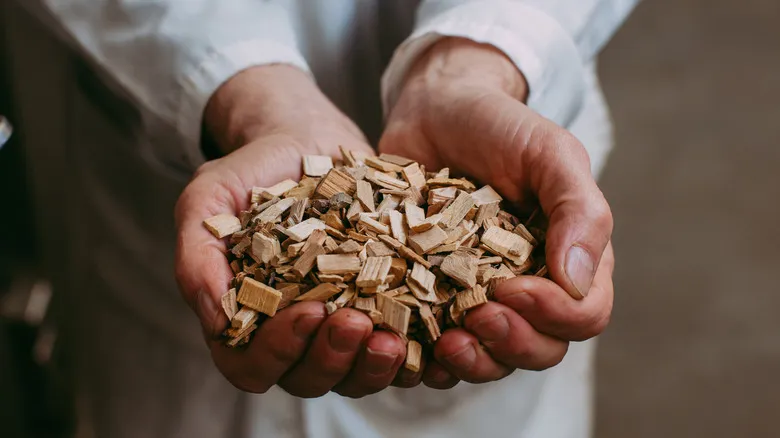
To enhance the distinctive flavor of your tender pork shoulder, think about the type of wood chips you’ll use in your smoker. Pork pairs beautifully with applewood and other lighter wood chips due to its mild flavor. Oak is another favored option, known for its versatility and commonly used with pork, chicken, and beef. Feel free to experiment with various wood chip types to discover the unique flavors they bring and how different options affect the smoke and cooking duration.
You can purchase wood chips online, such as this popular four-style bundle. Most hardware stores also stock wood chips for grilling, especially during peak grilling and smoking seasons, but be sure to select those that are safe for cooking. Grocery stores may offer wood chips, but they usually have a more limited selection compared to specialty stores that cater to grilling aficionados.
Refer to your smoker's owner's manual for instructions on how to add the chips to your setup. Many smokers feature a separate compartment that allows you to manage the chips and add more as needed without letting out too much smoke from the cooking area.
Hack your grill to turn it into a smoker
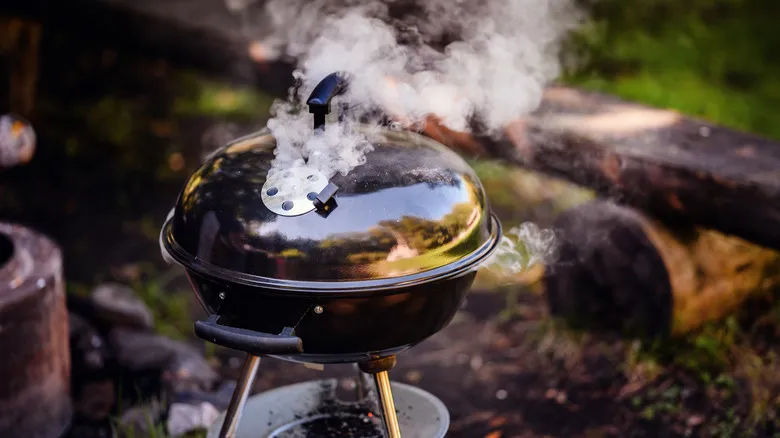
Having the right tools and setup is essential for achieving optimal results in any cooking endeavor, particularly when tenderness and flavor are paramount. "Using a smoker is ideal for cooking a pork shoulder because it allows for a low and slow approach," the McLemore Boys advised. However, if you don’t have a dedicated smoker, you can still achieve the same "low and slow" technique using your grill.
Since your grill likely lacks a designated area for wood chips, you can create a foil packet to contain them. Simply poke a few holes in the top of the packet to enable airflow around the wood chips, allowing the smoke to circulate within the grill. Additionally, place a shallow aluminum foil pan filled with a few inches of water inside the grill. As the grill heats up, the water will produce steam that combines with the smoke, imparting the desired flavor into the pork shoulder. Once you’ve generated a good amount of smoke, transfer the pork shoulder to a cooler part of the grill. It’s important to maintain a low temperature, ideally between 225 and 300 degrees Fahrenheit, for an extended period to ensure it becomes incredibly tender.
Know the temperatures you'll need for the best results
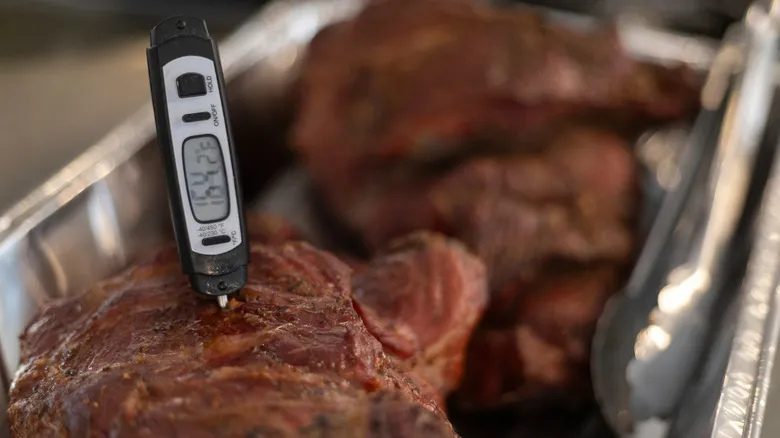
Knowing when the pork is fully cooked is crucial to prevent overcooking. The challenge lies in determining the internal temperature without creating too many holes in the meat. Each time you poke the shoulder, you release juices, resulting in drier meat. To minimize frequent checks, use a probe thermometer that allows you to monitor the temperature from outside. Ensure the pork shoulder reaches at least 145 degrees Fahrenheit to eliminate any risk of foodborne pathogens.
The McLemore Boys suggest slightly adjusting the target temperature for pulled pork to achieve a wonderfully tender result. "For sliced or chopped pork shoulder, smoke it unwrapped until the internal temperature reaches 165 degrees Fahrenheit, and it will be ready for chopping," they explained. "For pulled pork, smoke it unwrapped to 165 degrees Fahrenheit, then wrap the pork shoulder in either tinfoil or butcher paper, and return it to the smoker until the internal temperature reaches 205 degrees Fahrenheit, at which point it will practically fall apart."
Wrap your pork in foil
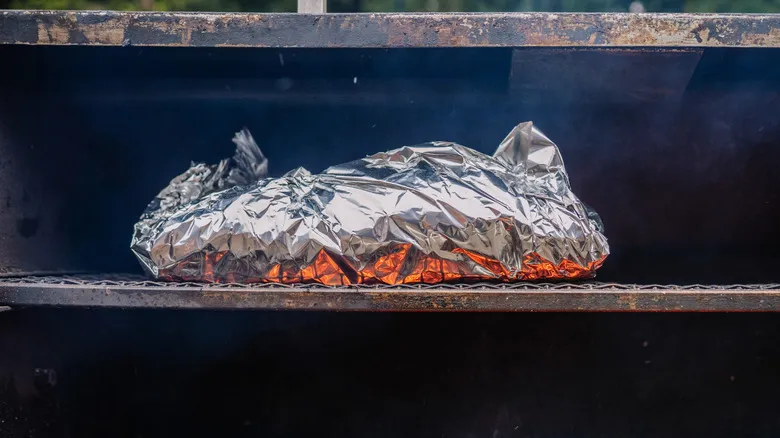
To truly enhance flavor and tenderness while smoking, consider wrapping the pork shoulder in foil. This technique helps retain the fat and juices close to the meat during the cooking process. Since fat is essential for moisture but tends to drip away as it melts, the foil acts as a barrier, minimizing moisture loss.
The McLemore Boys also gather the drippings while the shoulder cooks and then inject them back into the pork before sealing it in foil for the final smoking phase. This method ensures the meat remains as tender and juicy as possible.
Keep in mind that this step requires some careful handling, so be cautious around the hot areas of your smoker when collecting drippings. Some smoker models come with a removable drip pan, but it's wise to have a clean pan ready to place underneath the meat as it cooks. This practice helps keep your smoker clean and in optimal condition, ultimately prolonging its lifespan.
Don't overdo it on the smoke
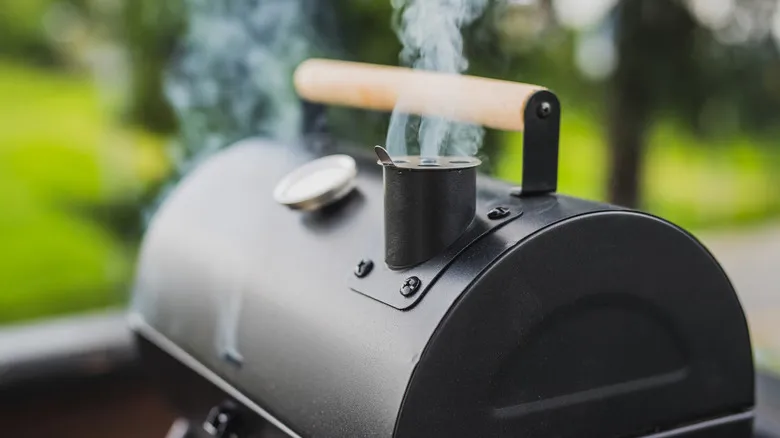
Your smoker shouldn't produce so much smoke that it obscures the setup. Keep an eye on the smoke color to assess quality and airflow. The McLemore Boys prefer to see thin, blue smoke instead of thick, white clouds or dark black smoke. The presence of thinner smoke indicates that the temperature is optimal and that air is circulating properly within the smoker. Excessive smoke can lead to dark, harsh smoke, imparting a bitter flavor to the final product, especially when using stronger-flavored wood chips.
A high volume of smoke may also suggest that the temperature is too elevated or that the heat is directly affecting the meat instead of the wood chips, which can cause the shoulder to lose excessive moisture. "The key with pork is not to overcook it, as it can become tough and dry," said Rosangela Teodoro. A steady, thin stream of smoke is essential for achieving the "low and slow" technique that The McLemore Boys advocate.
Burn off debris occasionally
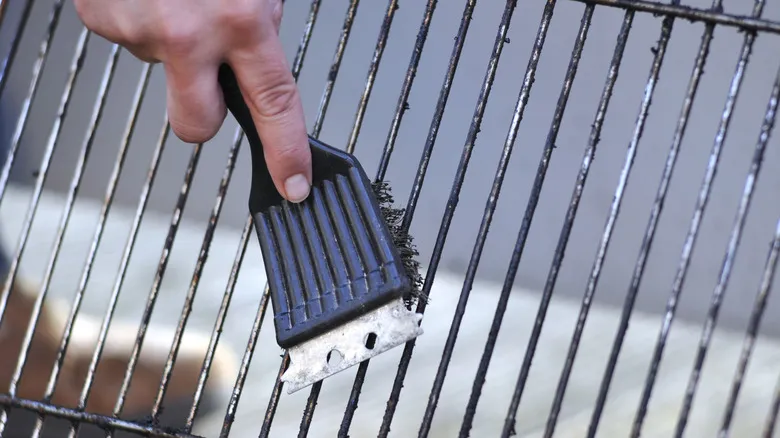
To maintain your smoker in excellent condition, it's advisable to occasionally crank it up to high heat to incinerate any leftover residue. This practice ensures it stays clean and ready for use. Every now and then, your smoker will require a thorough cleaning to tackle larger messes or signs of wear. "Make sure to scrub off any significant buildup, rust spots, or dirty areas," advise The McLemore Boys.
Using heat to clean grill grates is preferable to using a cleaning solution, especially when preparing the surface for a new batch of meat. Once the grates are heated, employ a sturdy grill brush to eliminate any food remnants. Don’t forget to dispose of used wood chips after smoking and replace them to enhance flavor and prevent the growth of harmful bacteria.
However, be cautious not to overdo it. The father-son team warns home cooks against excessive cleaning of the grill or smoker, likening it to a cast iron skillet. For optimal results, it should be seasoned to prevent sticking during the smoking process.
Let the pork rest before cutting it
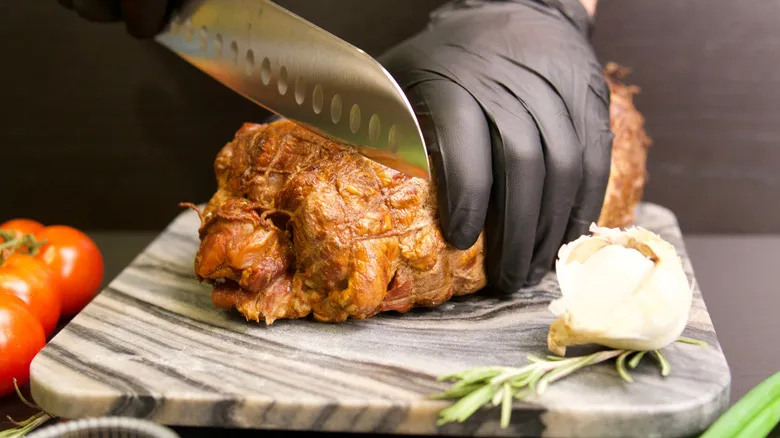
You might feel inclined to dive straight into your mouthwatering meal, but just like with any method of cooking pork shoulder, allowing the meat to rest after smoking is essential. These crucial minutes enable the juices to flow back into the tender meat, resulting in a more flavorful dish after a brief resting period. If you slice into the pork immediately, you'll notice all the juices escaping onto your cutting board. Letting those juices leak out will leave your pork shoulder dry and tasteless, negating all the effort you put into making it tender and juicy in the first place.
Rosangela Teodoro suggests letting the meat rest for five minutes after it comes out of the smoker. While you should take it off the heat source, remember that it will continue to cook as it cools down. The meat needs a moment to cool slightly for the juices to redistribute throughout the now-cooked flesh.
Recommended

Why The Biggest Lobster Isn't Necessarily The Best
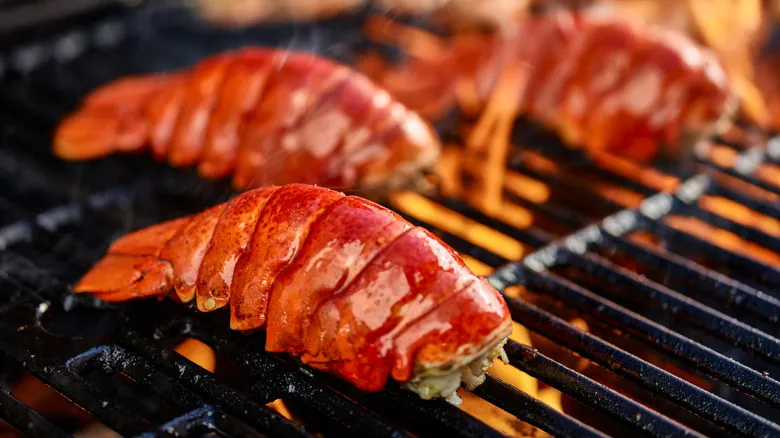
How To Prep And Grill Lobster Like A Pro
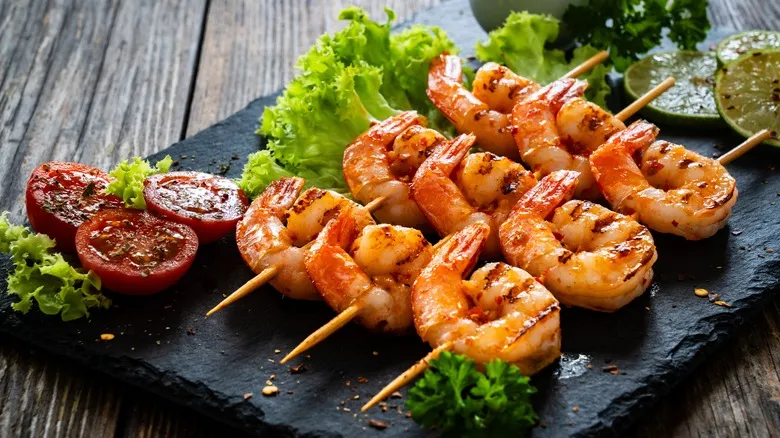
The Secret To Getting More Flavor From Your Shrimp Marinade On The Grill
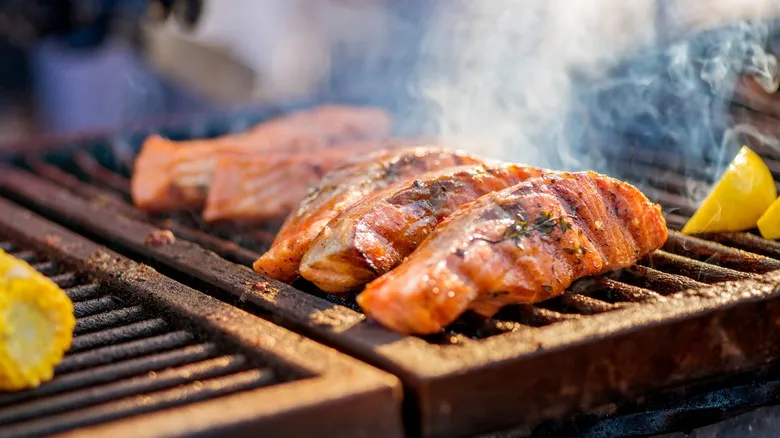
The Foolproof Trick For The Juiciest Grilled Fish According To A Chef
Next up

